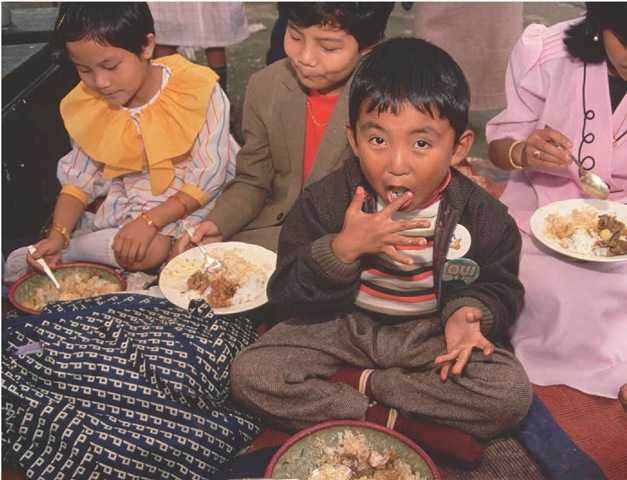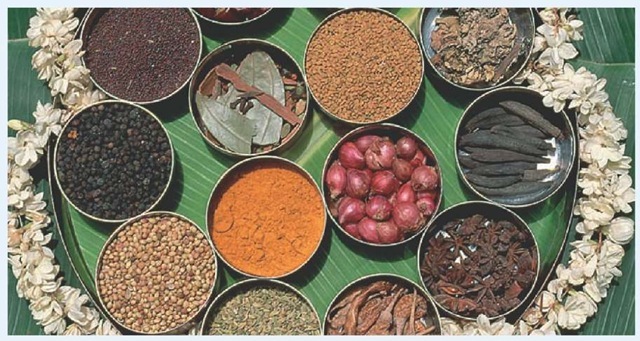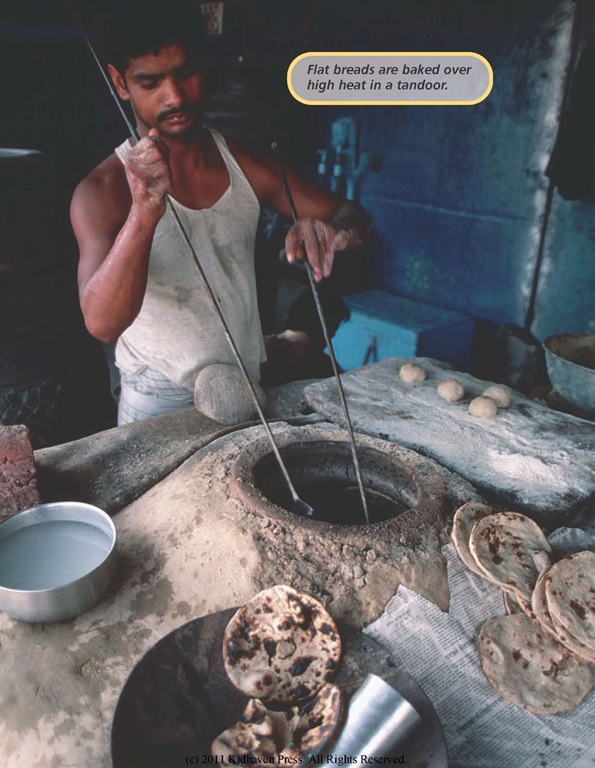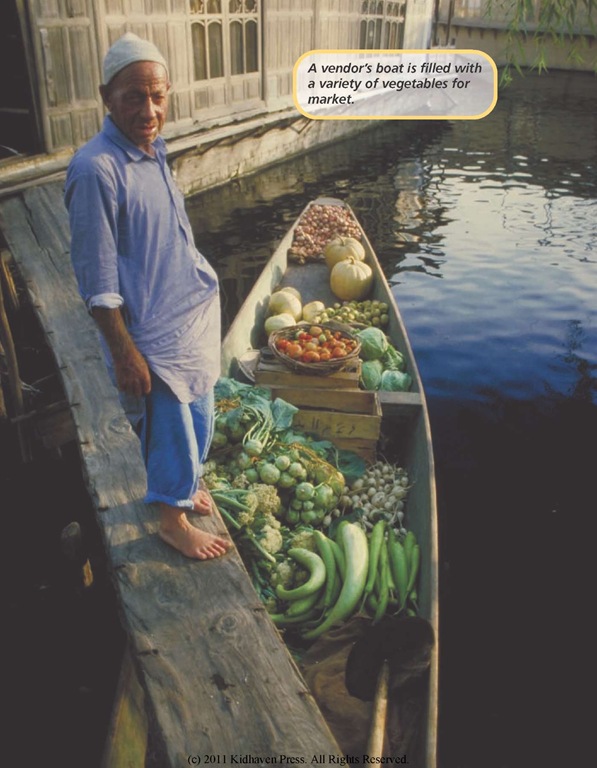India is a large country with many geographic differences. Plains, deserts, thousands of miles of coastline dotted with tropical beaches, and snow-capped mountains all are a part of India. This geographic diversity affects what the 1 billion people who live here eat. For example, coconuts, seafood, and tropical fruit are popular on the coasts where they are cultivated. Thick stews that warm the body are favorites in the cold mountains.
Religious rules also influence the Indian diet. Indians are divided into a number of religious groups. Eighty percent are Hindus and 13 percent are Muslims. There are also Sikhs and Buddhists, among others. Few Muslims eat pork, while most Hindus avoid beef. Many Hindus, Sikhs, and Buddhists are vegetarians. As a matter of fact, there are more vegetarians in India than in any other nation. Despite these differences, the use of spices and similar cooking methods bind all Indian cooking together.
Spicy Sauces
Curry is probably the most famous of all Indian foods. It is not a single dish and there is no basic recipe for it. Curry actually describes any dish cooked in a spicy sauce.
Mealtime is a special time for this boy and his family.
Spicy chicken curry is just one of many curries enjoyed by Indians.
This usage dates from the mid-1800s when the British ruled India. The British used the word curry, taken from the spicy Indian herb kari, for all spicy dishes. A wide range of popular, stewlike dishes are bathed in zesty sauces. Each has different main ingredients, but the basis for every one is a savory sauce made from a blend of aromatic spices.
Indian cooks create these sauces in layers. First a combination of spices, which usually includes garam masala, is cooked in hot oil or ghee with nuts or grated onions.
Then yogurt, which adds a pleasant tartness, or tomatoes follow. The main ingredients, which include a variety of vegetables and/or meat or seafood, come next. Water is added, and the stew is cooked until all the flavors blend deliciously and the ingredients are buttery soft.
Eating in India
Some mealtime customs in India are different from customs in North America. For instance, in India food is rarely served in serving bowls. Instead, each diner is given a round metal tray called a thali (taah-lee). On it are small bowls containing different dishes such as rice, dal, chicken korma, potatoes, chutney, and raita.
Instead of utensils, food is eaten with the right hand. The left hand, which is used for personal hygiene, is never used for eating. Diners use the tips of their fingers to pick up food and their thumbs to scoop the food into their mouths.
A thali, or food tray, holds a variety of foods and seasonings.
A favorite Indian dinner includes the hot and spicy stew called roghan josh, dal, rice, and flat breads.
Many Dishes
Indians make hundreds of different kinds of saucy, stewlike dishes, which are eaten with rice or roti. Depending on the spices, the stews can be fiery or mild. Kormas (kor-maahs), for instance, are rich and mild. Main ingredients such as vegetables, chicken, lamb, or seafood are smothered in a creamy sauce flavored with cinnamon, nutmeg, pepper, and mustard seeds. The mixture is then thickened with coconut milk and almond paste. The result is fragrant, velvety, and delicious.
Zestier stews are also quite popular. Roghan josh (ro-gahn josh) is hot and spicy. Its sauce is made with garam masala cooked with lamb and topped with fried tomatoes and onions. Vindaloo (vin-dah-loo) dishes are even hotter. Pork vindaloo is popular, but vindaloos also feature vegetables or lamb. The main ingredient is marinated in a sweet-and-sour sauce made of vinegar, ginger, and garlic. This mixture is then topped with a second sauce flavored with cumin, turmeric, and whole, dried chilis. Even though vindaloo dishes are fiery, the taste is not unpleasant. Like all Indian stews, vindaloo has a delicate flavor that lingers on the palate. "I call this back heat," explains Suvir Saran. "It goes and goes in your mouth long after you’ve swallowed the bite!"5
Crisp, Moist, and Succulent
Other deliciously spiced foods are cooked in a tandoor (tahn-dur). A tandoor is a barrel-shaped clay oven. It was brought to India in the 10th century by Persians fleeing their Arab conquerers.
Much like Americans have barbeque grills, some Indians have a tandoor in their backyards. For those who do not have one, there are tandoor restaurants, which are the most popular restaurants in India.
To use a tandoor, cooks build a charcoal fire in its bottom. The heat can reach as high as 850°F (450°C). Such intense heat cooks food rapidly and locks in moisture. Food cooked in a tandoor is crisp on the outside and soft and juicy within.
Most any food can be cooked in a tandoor. And many different foods can be grilled, baked, or roasted at the same time. "It must be the most versatile oven in the world," says Baljekar. "The cook can, as if by waving a magic wand, produce a variety of dishes."6
Chicken Tikka
Chicken tikka can be made on a grill or in an oven. The longer the chicken marinates, the tastier it gets.
Ingredients
cup plain yogurt juice of 1 lemon 1 teaspoon cayenne pepper 1 teaspoon chili powder 1 teaspoon grated ginger 1 teaspoon turmeric 1 teaspoon salt 1 tablespoon tomato sauce 4 chicken breasts, cut into cubes
Instructions
1. Mix all the ingredients except the chicken together in a large bowl. Add the chicken. Put in the refrigerator to marinate one hour to overnight.
2. Preheat the oven to 375°F. Put the chicken on skewers. Place the skewers across a drip tray sprayed with nonstick spray or lined with aluminum foil.
3. Cook the meat until it is no longer pink inside, about twenty minutes. Serve with mint chutney.
Mint Chutney
Mint chutney is served with almost every meal. Chopped green mango can be used to add tartness. Use more chilis for a spicier taste and fewer for a milder taste.
Ingredients
1 cup fresh mint leaves 1 cup fresh cilantro, chopped
3 green onions, chopped
2 green chilis, chopped, seeds and stem removed 1 teaspoon minced ginger 1 teaspoon minced garlic
1 teaspoon sugar J2 teaspoon salt
2 tablespoons water juice of one lemon
Instructions
1. Combine all ingredients in a food processor or blender. Puree until the mixture becomes a paste.
2. Makes one cup. Refrigerate until ready to serve. Serve with any Indian dish or with crackers.
Until the 19th century, tandoors were used just to bake naan (nahn), an Indian flat bread. Naan is made by pressing dough onto the hot oven’s walls. Many Indian villages had a communal tandoor in the middle of the town that villagers used to make their bread.
Today whole chickens, known as tandoori chicken, and chunks of lamb or chicken, known as tikka (tee-kah) kebabs, are commonly made in the clay oven. To make these dishes, the cook marinates the meat in a spice-laden yogurt mixture. The marinade flavors and tenderizes the meat. The spice mix, called tandoori masala, includes flavorless red food coloring that gives the food a vivid,reddish-pink hue.
Because the longer meat marinates, the more intense the flavor, this step can range from an hour to days. Before it is placed in the oven, the meat is brushed with ghee. Then it is threaded through a long, metal skewer and cooked. The cooked meat or chicken is served with rice or roti, cooked onions, and various relishes. It is incredibly succulent and smells delicious. "The food absorbs both the subtle earthy scent naturally released by the clay and the wisps of fragrant smoke created by . . . drops of marinade falling on the white-hot coals,"7 explains an expert at Golden Tan-doors, a company that designs ovens.
Flavorful Accompaniments
Whether Indians are feasting on tandoori chicken or roghan josh, no meal is considered complete without raitas (rye-tahs) and chutneys. Served in small, round bowls and eaten right along with the rest of the meal, these lightly spiced relishes cool the palate and bring still more flavor and color to the table. Cooks mix together yogurt, raw vegetables or fruits, and various spices to make cool and creamy raitas. The relishes provide a soothing contrast to highly spiced dishes.
There are hundreds of different kinds of raitas. Cucumber-mintraita is one of the most popular. Pineapple raita, which blends the sweet fruit with yogurt and a bit of pepper, is a delightful mix of different flavors.
Chutneys also come in a wide range of flavors. These homemade, fresh relishes contain fruits and vegetables cut into tiny pieces and delicately flavored with spices. Chef Diane Seed explains: "Most Indian families take pride in their homemade . . . chutneys. . . . Houses are adorned with rows of jars maturing in the sun on the windowsills, and a hostess is often judged by the number of relishes she serves."8
It is quite common for a variety of raitas and chut-neys to be served at one time, and each cook has his or her own special recipes. Mint chutney, which combines fresh mint, onions, garlic, and lemon juice, is quite popular. Coconut chutney is also a favorite. It mixes freshly grated coconut with ginger, garlic, kari leaves, and dried chilis. Other chutneys are made from tomatoes, green mangoes, and apples. All are brightly colored and taste sweet, hot, and tart all at the same time.
No matter where you go in India, chutney and raita are likely to be served. Although Indian cooking is diverse, flavorful dishes cooked in spicy sauces or in a tandoor oven and served with these tasty relishes are loved throughout India. Such dishes share similar cooking methods and a common use of spices. These are the threads that tie all Indian cooking together.






